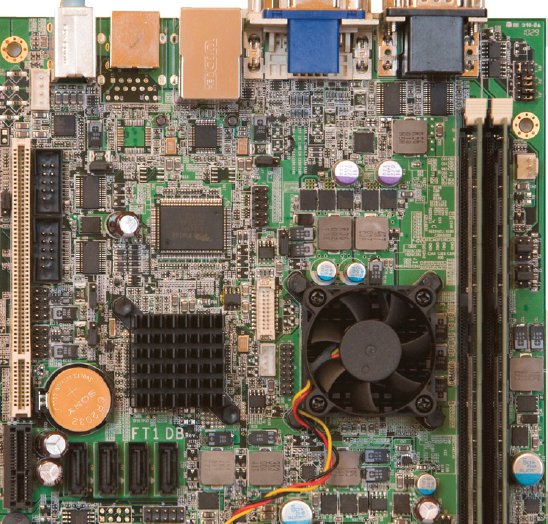Earlier this year, AMD announced its new Embedded processors G-Series aimed at set-top boxes, smart tv, digital signage, point of sales, media servers and more in order to compete with Intel Atom solutions as well as ARM based processors.
Please refer to the link above for an overview and details about the 5 processors of the AMD G-series:
- T56N – Dual core @ 1.6GHz with Radeon HD 6310 GPU
- T48N – Dual core @ 1.4 GHz with Radeon HD 6310 GPU
- T40N – Dual core @ 1.0 GHz with Radeon HD 6250 GPU
- T52R – Single core @ 1.5 GHz with Radeon HD 6310 GPU
Today, I’ll discuss about the development boards and software development kits available for this platform.
AMD G-Series Development Boards and Reference Designs
AMD Provide two reference designs and one development board:
- AMD Embedded G-Series Platform Mini-ITX Reference Design. No details are publicly available as this mini-ITX reference design requires you to sign an NDA for full details. However for mini-ITX you may refer to DB-FT1 development board below.
- AMD Embedded G-Series Platform Mobile Reference Design. No details are publicly available as this Mobile reference design requires you to sign an NDA for full details.
- AMD DB-FT1 Development Board: The DB-FT1 development board (mini-ITX form factor board), supporting either the two-chip Ball Grid Array (BGA) packaged dual-core AMD Embedded G-T56N processor with AMD Radeon™ HD 6310 graphics, or dual-core AMD Embedded G-T40N processor with AMD Radeon™ HD 6250 graphics, combined with the AMD A55E controller hub, enables customers to fully explore the rich feature set of the platform. Supporting 2D and 3D graphics, video acceleration, and dual independent display support through a variety of display interfaces such as eDP, DVI, DisplayPort, LVDS, HDMI™, and VGA

The DB-FT1has the following characteristics:
- VGA, DVI-D, 18-bit single-channel LVDS support
- 1 PCI slot (33MHz/32-bit)
- 1 PCIe® x1 slot
- 4 SATA 3Gbps ports (with RAID 0/1/5/10)1
- 8 USB ports (4 I/O, 4 internal)
- 4 Serial ports (RS232/RS422/RS485)
- Controller hub integrated clockgen
- Automated fan control (CPU TSI support)
- Fintek F81865-I SIO
- Realtek 8111DL PCIe GbEx1 LAN controller
- Realtek HD audio codec ALC269
- ATX power input
and the following ports:
- 1 RJ45 Ethernet jack
- 1 DVI-D connector (or HDMI passive adapter of customer’s own provision)
- 1 VGA connector
- 4 USB ports
- 3 x 1/8″ phono audio jacks (2-ch amplified out, line in, mic)
- 2 DB9 Serial port connectors
Alternatively you could also consider one of Seco’s QSeven form factor development boards.
AMD Fusion G-Series Software Development Kit and Developers’ Support
AMD Provides support for the following:
- Embedded Developer Support
- Driver Downloads
- Technical Documentation (non-NDA)
- Linux Support
- OpenCL Zone
Support is very limited and not so easy to navigate (especially for the first three items) , however you may be able to get more info on AMD Developers’ Forum.
There is the open source zone one AMD website with links to different open source projects supporting AMD Embedded Processors such as GCC and GNU Tools – where you’ll be able to download the GCC compiler for AMD processors -, o-profile, qemu, the graphics drivers…
The most documented part is OpenCL (Open Computing Language), an open and royalty-free programming standard for general-purpose computations on heterogeneous systems. OpenCL allows programmers to preserve their expensive source code investment and easily target multi-core CPUs, GPUs, and the new APUs. You’ll be able to download AMD APP SDK with OpenCL 1.1 support for Windows XP, Windows Vista, Windows 7 and Linux distributions such as OpenSUSE or Ubuntu in both 32-bit and 64-bit ersions.
For Example for Windows XP 32-bit, you can download the latest version ati-stream-sdk-v2.3-xp32.exe (79.2MB) release in December 2010.
APP stands for Accelerated Parallel Processing as it makes use of multi-core and the GPU. The AMD APP SDK was previously known as ATI Stream SDK (hence the name of the file).
This SDK supports the following compilers:
| Microsoft® Windows® | Intel® C Compiler (ICC) 11.x Microsoft® Visual Studio® (MSVS) 2010 Professional Edition Microsoft® Visual Studio® (MSVS) 2008 Professional Edition Minimalist GNU for Windows (MinGW) [GCC 4.4] |
| Linux® | GNU Compiler Collection (GCC) 4.1 or later Intel® C Compiler (ICC) 11.x |
Other Tools are also available for code optimization (for Windows OS only):
- AMD APP Profiler: Microsoft Visual Studio integrated runtime profiler that gathers performance data from the GPU as your OpenCL™ or DirectCompute application runs.
- AMD APP KernelAnalyzer: Tool for analyzing the performance of OpenCL™, Brook+ and IL kernels for ATI Radeon™ graphics cards.
There are also many other CPU and GPU tools on AMD Developer’s Website.

Jean-Luc started CNX Software in 2010 as a part-time endeavor, before quitting his job as a software engineering manager, and starting to write daily news, and reviews full time later in 2011.
Support CNX Software! Donate via cryptocurrencies, become a Patron on Patreon, or purchase goods on Amazon or Aliexpress




